|





























| |
MONEYPIT South - 10/18/2003
In this multi-part MONEYPIT story, we follow the tale of EMI M400
#103S.

 |
Jamie Robertson (new to MONEYPIT) and I wandered over to see what we
could do with EMI M400 #103S that Paul Santo currently owns.
The complaint? Dodgy notes. The cause? The
usual...BUT...it's also an EMI-made M400...
|
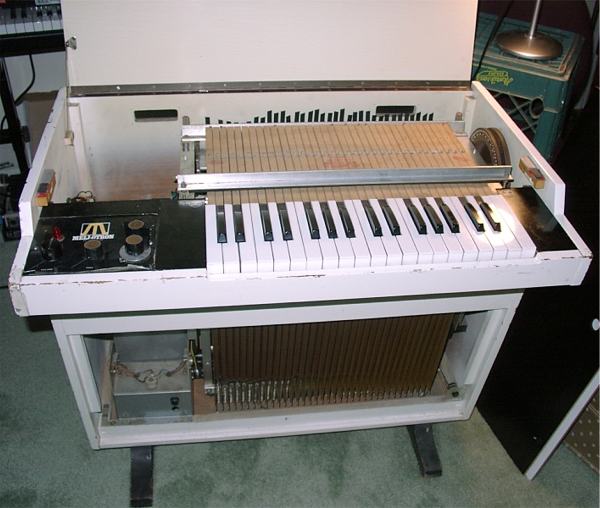
EMI E4/103S
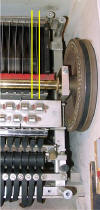 |
If you've seen
Norm Leete's EMI M400 story, then you know what running into an EMI M400
is like. He nails it right on the head:
| Some of the problems included old motor control
board, sub-standard power supply and the mechanics out of square. I
had never really considered the latter but it really is very important
that the internal frame is square. Mine wasn't so the keyboard was
hard work to remove when changing tape frames plus as the tapes were
not perpendicular to the heads the treble response of the machine was
poor. The mis-alignment also meant that the tapes dragged on the
guides so the pinch wheels had been adjusted to increase the pressure
on the capstan (they were at the bottom of their adjustment) and still
some tapes would drag. In some cases this was so bad they would squeak
while playing. |
Jamie and I arrived to check out the EMI unit, and owner
Paul got caught up on a number of other things (his schedule is usually
packed, so having a Saturday free was quite unusual) while there was the
usual Mellotron adjustment cacaphony going on, but he spent time with
us to go over the machine as well.
It's hard to believe the number of items that Norm nailed
on his web page as applying to E4/103S as well---unfortunately.
 |
The motor controller was previously replaced with an
SMS-5, so that work was done. The power supply seemed to be a stock
M400 supply, but I didn't do anything with it.
|
 |
The keyboard was hard to remove, as if held on by a
magnet. That was bizarre.
|
 |
It appears that the take-up box is out of square with the
tapes (see picture to left).
|
 |
The pinch rollers for the top notes were cranked down to
the bottom of their adjustment and still didn't play right. The
bottom notes were better.
|
I would try my best, folks, but only could get the machine
so far---better than before, but not where it should be and can be.
It likely needs a Leeting.
Some other observations (most we knew about before from
Andrew's EMI)...
 |
It's painted white. The original finish can be seen
under the old serial number plate, which probably fell off somewhere.
Shame, as I like the original finish on those cabinets. Paul
informed me, though, that many EMI units did leave the factory white, so
this could be a factory paint job.
|
 |
It appears that they had to chisel out some room for the
front of the keyboard (probably done at the factory to make room for the
keyboard).
|
 |
Brass capstan.
|
 |
Short keyboard frame.
|
 |
Cheek blocks are metal, not thick wood blocks as in the
M400.
|
 |
Unfortunately the front and top pieces of this unit's lid
have separated.
|
 |
The tapes are from Mellotron Archives (cello, 3-violin,
flute).
|
 |
Missing one of the keyboard thumbscrews.
|
 |
The tape frame has a tape fastening screw snapped off.
|
 |
Then there was the pitch control...
|
|
Pitch control...
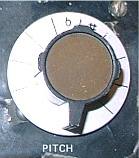
This one had me stumped.
The pitch control is geared so that one turn of the knob is about
1/10 turn on the pitch control itself. I don't know if this is
original or a replacement that someone made. Well, no real
pitch dives on this box while playing, I guess! |
So what we attempted to do in the span of a few hours was
to oil up and adjust the machine to get it as good as it could be in the
as-is state. I had a sinking feeling it wouldn't be enough, given
Norm's experience, but I had to try.
 |
The motor and capstan eagerly sucked up the oil I
provided, and they ran more smoothly afterward.
|
 |
Heads and capstan were cleaned.
|
 |
The rollers were inspected. All turned OK, some
chips here and there, but in fairly good condition.
|
 |
Adjusted. Painfully. Several hours.
Mellotronists' Hunchback. Thankful for Jamie's help near the end.
Some rollers blurbled on some of the tapes, so I took the shine off them
and cleaned them up, and they worked much better. One key in the
middle (D) was stubborn and wouldn't really adjust all that well. It
plays, but it's hard to press down, as the pinch roller obviously requires
a lot of pressure to operate now.
|
 |
While we went along, Jamie and I observed tapes there were
worn rather strangely--along their length--under some keys. Three
things cause that, but only two I could tweak:
 |
Some pinch rollers weren't parallel to the tape path, thus
pushing the tape sideways. I held my breath and gently twisted them
back straight with some channel lock pliers.
|
 |
Some pinch roller holders weren't parallel to the key they
were on. Fortunately the screws allow for a small amount of
adjustment, and sometimes that millimeter or two really helps.
|
 |
Something's out of square. Not much I could do in an
afternoon for that.
|
|
 |
We also got a lot of blurbling on some notes, and this
seemed to be in concert with the motor vibration. The only way I
could get rid of those was to crank down the pinch roller and pressure pad
a bit more than they probably needed to be.
|
 |
One of the pinch rollers seemed to be a Mellotron Archives
replacement. It was not secured, just snapped into place, and one
side of the axle was loose. I swapped it into key #35 and crimped it
as best I could. I don't know the best way to get those to stay in
other than that, but I'm sure there's a decent method available.
|
 |
I adjusted the "glad to see ya!" keys (several key return
spring nylocks were cranked too far), loosened up the holes at the front of the keys so
the keys weren't hung up on the posts, and adjusted the key height to something Paul
thought was OK (I didn't have a ruler there for the 3/4" throw).
Jamie helped with a few, too.
|
So after all that...?
Let's say that the reviews are mixed. It certainly
played and felt better by the end. When we left, the machine was
able to hold pitch on most notes, but some were still tenuous.
Chords were interesting at best, but Paul thought that he could at least
use the machine after all that...
...well, 'til he tried it later on, and some of the dodgy
notes were back. Paul will be able to take care of these somewhat,
I'm sure, but I'm still haunted by "it's an EMI...square up the
frame...disassemble it, square it up...".
O Mellotron Professor: I'm tired of running into bears, ya know?
:-)
I let Paul know about the experience that Norm Leete had
with his EMI M400 and various bits of contact information that should be
helpful if he decides to have this machine squared up. I would like
to see it right as rain, as it is pegged to be used on recordings coming
up!
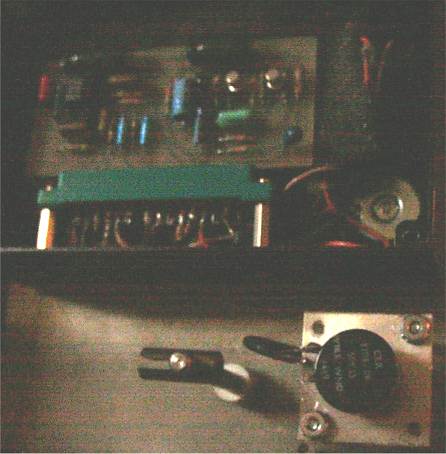
Single card preamp
EPILOGUE
Without a rebuild, the machine would only get as good as
"just good enough but you kinda know something is wrong, and it's just
enough to notice." Your Humble Scribe housed this machine for about
a month over the winter '03-'04 and tried everything outside of
dismantling it completely, including squaring up the frame a little.
But there was still something wrong, especially on wide chords---just
enough to be aggravating.
With the purchase of a nice little
M400, the EMI's fate was sealed. Over
Memorial Day Weekend 2004 the machine
was made "good enough" after having parts scavenged earlier---it was once
again running and making sound. But on June 1, 2004 the EMI was put
into the back of the car and brought to a local music shop as a trade in.
One thing will always haunt me about that machine, though.
I was advised against adjusting the SMS-5 motor controller in the EMI, and
eventually it proved to be out of whack when installed into the M400 over
Memorial Day Weekend---my ears caught it ("Jeez, this is just like the
EMI!"), and thankfully Jerry Korb had the adjustment procedure for the
SMS-4, and we improvised and made the SMS-5 much better. I don't
think that adjusting the SMS-5 would have been the complete answer for
this EMI (ask Norm Leete!), but it may have been one good step in the
right direction, and maybe it would have been "good enough" after all?
Sigh...
|
Continue to Part 2: Return to
MONEYPIT South. -->

| PAUL
SANTO...

|
| Paul is a
songwriter/musician/producer/engineer from the Boston, MA area. He's currently working with a
local band
rocketscience to produce their first
album, and he has been providing keyboard work for Aerosmith for quite a
while now.
Paul recently toured and recorded with Ringo Starr.
Paul was half the team that did the recording work for "RINGO RAMA",
released in the spring of 2003. Paul had the opportunity to work with Eric
Clapton and David Gilmour during the recording sessions. In addition,
he co-wrote one song on the album and contributed electric guitar and bass
tracks.
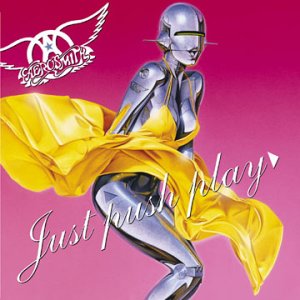
A platinum album graces Paul's wall.
It's from Steven Tyler, with thanks for his contributions to Aerosmith's
platinum-selling "Just Push Play": Hammond organ on "Avant Garden";
Kurzweil on "Fly Away From Here".
And sitting next to a James Brown doll: a
Latin Grammy! |
Paul has a variety of instruments from which to choose,
including any number of guitars (a 50 year old Gibson acoustic is a fave--old,
but sound that's rich and full with the right amount of grit), a wonderful
'70 or '71 Fender Precision bass, Wurlie electric pianos, a honkin' Kurzweil,
Hammonds (and Leslie), and even an Optigan.
The real center of his collection, however, is guitar amps,
all vintage (one new for good measure). Marry that to an array of guitar effects, and you have
just about any guitar sound you'd ever want! |
|
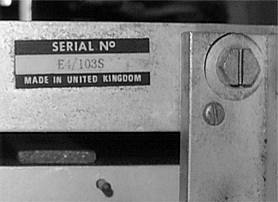
EMI M400 #103S's role is now being
taken up by M400 #1428. |

Original pictures & text by Ken Leonard
Corrections/clarifications from Paul Santo---thanks!
Please note that Yours Truly does NOT take any money for his
work on Mellotrons and has never professed to be anything other than an amateur.
If I'm unable to get a machine 100%, it's not from a lack of trying or from
anything less than a best effort. The owner of the machine understands
this, as did Paul with the EMI. I'm just sorry that it didn't work out
with this one on this go 'round.
Other folks are available to repair or restore your machine
professionally. Post to the
Mellotronists
list if you would like your machine done over by someone who knows all the ins
and outs. It is not inexpensive, but there's a lot of real talent out
there on the list from repairs to the M400 to specialized repairs on the Mark II
and M300.
|
